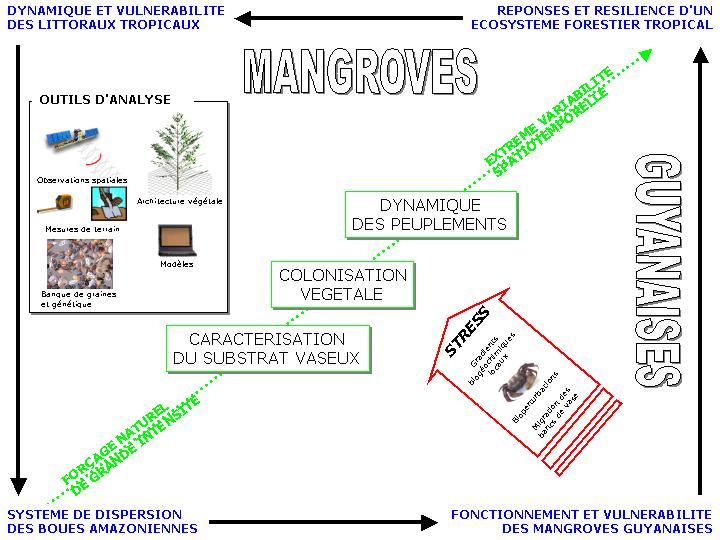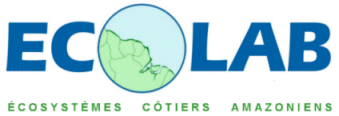|
Vers des projets communs...
Mars 2008
MANGROVES
UNDER AMAZON INFLUENCES (MANGAS): a paradoxical resilience ?
Abstract: The coastal mangrove forests
of French Guiana are subject to intense oceanographicsedimentaryconditions
and are characterized by relatively low plant biodiversity within the Amazon
region, yet paradoxically, they are resilient. How can such resilient ecosystems
be realized and sustained in this physically dynamic context, and to what
extent are the ecological concepts generalizable? Based on recent research,
we think that mangrove ecosystem resilience islargely determined by the exceptional
capacity of mangroves to colonize newly available mudbank substrate rather
than resistance to erosional processes. An interdisciplinary team has been
assembled within the proposed project: MANGAS, to evaluate this hypothesis,
and specifically to characterize and explain the physical–biological interactions
that play a role in establishing pioneering mangroves and the rapid expansion
of mangrove forest. The proposed study will be conducted at the station scale
(intertidal mud, propagule fluxes), at the French Guiana scale (sedimentary
and hydro-climatic processes), and at the larger regional scale (the Amazon
dispersal system). MANGAS fits into a rich national and international scientific
framework. In the end, its ambition is to form a research team in French Guiana
dedicated to the study of Amazonian mangrove and coastal dynamics.
Current status: in revision
MANGAS web site
|

|
FRENCH CALLS FOR COLLABORATION (FRENCO)
Idea:
French Guiana coastal dynamics depends on Amapá coastal dynamics.
Although there is a geographic continuity of ecosystems and the influence
of Amazon sediment discharge, functioning, phenomena and characteristics
may be extremely different. Taking benefits from understanding of both
regions is promising for developing and calibrating a range of methods
in biology, ecology, sedimentology, geomorphology and remote sensing. French
scientists need collaborations with Brazilian scientists to help their
studies dedicated to the study of the French Guiana coastal dynamics. These
collaborations may be initiated as following.
Principle:
A student in ‘mestrado’ or ‘graduação’
of the north-eastern Brazil is coached by a local scientist within the
frame of its university formation. Theme and proposal of collaborations
are discussed by Brazilian and French scientists in order to define a work
planning adapted for all. One of the main criteria should be a opportunity
for a rapid publication in an international journal.
|
|
BRASILIAN CALLS FOR COLLABORATION (BRANCO)
Idea: The study of the Amazon coastal region
requires a wide range of techniques, skillness, materials which are difficult
to combine at the same time in the same region of study without collaborations.
Although the following propositions of collaborations do not give direct
information for the study of French Guiana coastal dynamics, the development
of a common base of methodologies to measure processes occurring in the
Amapá or Pará regions may contribute to reinforce
efficiency of methodologies used in other regions. Within this frame,
the BRANCO proposition combines the formation of a student (1 month?)
which will have to user material, method in another context and will come
back to its region of experiment in Brasil to apply it.
Principle:
A student in ‘mestrado’ or ‘graduação’
of the north-eastern Brazil is coached by a local scientist within the
frame of its university formation. Theme and proposal of collaborations
are discussed by Brazilian and French scientists in order to define a work
planning adapted for all. One of the main criteria should be a opportunity
for a rapid publication in an international journal.
|
|
Séminaire
'Littoral Guyanais', Janvier 2007, Wilmereux, MREN/ULCO
Ce séminaire a permis
de dresser un premier cadre de réflexions décliné
en 3 axes:
Titre:
Fonctionnement et vulnérabilité
d’un littoral amazonien encore préservé. Application à
la Guyane.
Axe 1: Dynamique
de la zone cotière PI: Hubert Loisel ?
1. Transit et saisonnalité
du panache amazonien
2. Hydrodynamique sédimentaire
des bancs de vase
Axe 2 : Dynamique
des paysages littoraux PI: Christophe Proisy ?
1. Géomorphologie côtière
2. De la vase au sol (consolidation/
dessication/ chenaux…)
3. Ecosystèmes mangrove
(colonisation et développement)
Axe 3 : Vulnérabilité
et gestion des côtes sous influence amazonienne PI: Laurent
Polidori ?
1. Etat sanitaire (biologique/
métaux…)
2. Risque érosif. GIZC.
Intégration Surinam, Guyana, Brésil
|
Liste
des
présentations
|
Séminaire
Mangroves Guyanaises, Octobre 2005, Toulouse, Ladybio

Cliquez sur l'image pour agrandir ou télécharger
|
Résumé scientifique
détaillé
Article
résumé
|
|


